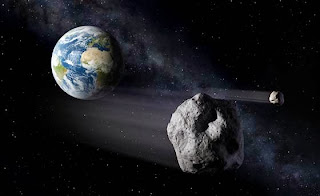Asteroid threat in 2032? Don't panic, but don't brush it off, A big asteroid sailed past Earth last month, and astronomers haven't yet totally excluded the possibility that it'll hit us when it comes around in 2032. If the past is any guide, we won't have to worry about asteroid 2013 TV135 — but it's a reminder that we'll have to fend off a killer space rock one of these days.
Ukrainian astronomers discovered 2013 TV135 just 10 days ago, well after the asteroid had its close encounter with Earth on Sept. 16. Actually, it wasn't all that close: The distance was 4.2 million miles (6.7 million kilometers), or about 17 times as far away as the moon. But based on the rough estimates of its orbital path, experts rated its chances of colliding with Earth during a follow-up encounter in 2032 at 1 in 63,000.
"To put it another way, that puts the current probability of no impact in 2032 at about 99.998 percent," Don Yeomans, manager of NASA's Near-Earth Object Program Office at the Jet Propulsion Laboratory, said Thursday in a statement. "This is a relatively new discovery. With more observations, I fully expect we will be able to significantly reduce, or rule out entirely, any impact probability for the foreseeable future."
Russia sounds alarm
Earth has faced tougher odds: At one point, astronomers gave the asteroid Apophis a 1-in-40 chance of hitting Earth in 2029. Further observations ruled out any chance of impact in the foreseeable future, and the case of 2013 TV135 will almost certainly play out the same way.
That didn't stop Russian Deputy Prime Minister Dmitry Rogozin, who has space research as part of his portfolio, from tweeting an alarm. "'A 400-meter asteroid threatens to blow up the Earth,'" he wrote in Russian. "Well, that's a super goal for domestic space."
Just last month, Energy Secretary Ernst Moniz signed an agreement with Russian officials that the Energy Department said would include seeing whether nuclear weapons could be used as a means of asteroid defense.
Nukes or not, asteroid defense is an international issue well worth contemplating: A space rock that's 1,300 feet (400 meters) wide could destroy a region or set off a huge tsunami if there were a direct hit. The asteroid that caused a meteor blast over Russia earlier this year, injuring more than 1,600 people, was a mere 17 meters (54 feet) wide when it hit Earth's atmosphere.
The United Nations is in the midst of figuring out the procedure for international action in the event of an asteroid catastrophe — and NASA's OSIRIS-REx mission, due for launch to asteroid Bennu in 2016, may help astronomers develop strategies for diverting a potentially threatening space rock. But for now, the big challenge is to identify and characterize near-Earth objects on a timely basis. The fact that 2013 TV135 was discovered only after last month's close encounter demonstrates how far we have yet to go.
Ukrainian astronomers discovered 2013 TV135 just 10 days ago, well after the asteroid had its close encounter with Earth on Sept. 16. Actually, it wasn't all that close: The distance was 4.2 million miles (6.7 million kilometers), or about 17 times as far away as the moon. But based on the rough estimates of its orbital path, experts rated its chances of colliding with Earth during a follow-up encounter in 2032 at 1 in 63,000.
"To put it another way, that puts the current probability of no impact in 2032 at about 99.998 percent," Don Yeomans, manager of NASA's Near-Earth Object Program Office at the Jet Propulsion Laboratory, said Thursday in a statement. "This is a relatively new discovery. With more observations, I fully expect we will be able to significantly reduce, or rule out entirely, any impact probability for the foreseeable future."
Russia sounds alarm
Earth has faced tougher odds: At one point, astronomers gave the asteroid Apophis a 1-in-40 chance of hitting Earth in 2029. Further observations ruled out any chance of impact in the foreseeable future, and the case of 2013 TV135 will almost certainly play out the same way.
That didn't stop Russian Deputy Prime Minister Dmitry Rogozin, who has space research as part of his portfolio, from tweeting an alarm. "'A 400-meter asteroid threatens to blow up the Earth,'" he wrote in Russian. "Well, that's a super goal for domestic space."
Just last month, Energy Secretary Ernst Moniz signed an agreement with Russian officials that the Energy Department said would include seeing whether nuclear weapons could be used as a means of asteroid defense.
Nukes or not, asteroid defense is an international issue well worth contemplating: A space rock that's 1,300 feet (400 meters) wide could destroy a region or set off a huge tsunami if there were a direct hit. The asteroid that caused a meteor blast over Russia earlier this year, injuring more than 1,600 people, was a mere 17 meters (54 feet) wide when it hit Earth's atmosphere.
The United Nations is in the midst of figuring out the procedure for international action in the event of an asteroid catastrophe — and NASA's OSIRIS-REx mission, due for launch to asteroid Bennu in 2016, may help astronomers develop strategies for diverting a potentially threatening space rock. But for now, the big challenge is to identify and characterize near-Earth objects on a timely basis. The fact that 2013 TV135 was discovered only after last month's close encounter demonstrates how far we have yet to go.

No comments:
Post a Comment